2007 CHEVROLET CORVETTE brake
[x] Cancel search: brakePage 227 of 488
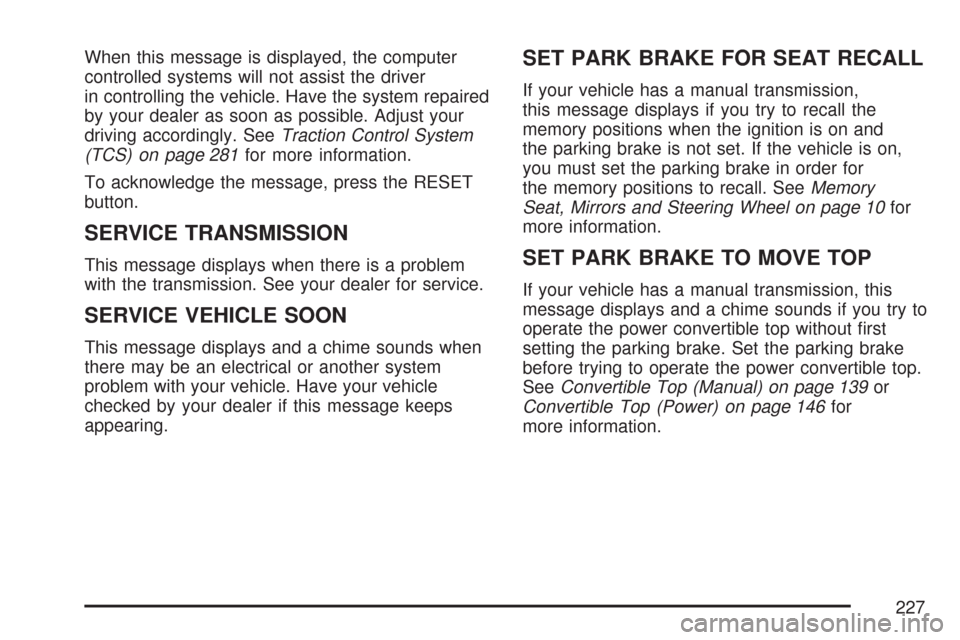
When this message is displayed, the computer
controlled systems will not assist the driver
in controlling the vehicle. Have the system repaired
by your dealer as soon as possible. Adjust your
driving accordingly. SeeTraction Control System
(TCS) on page 281for more information.
To acknowledge the message, press the RESET
button.
SERVICE TRANSMISSION
This message displays when there is a problem
with the transmission. See your dealer for service.
SERVICE VEHICLE SOON
This message displays and a chime sounds when
there may be an electrical or another system
problem with your vehicle. Have your vehicle
checked by your dealer if this message keeps
appearing.
SET PARK BRAKE FOR SEAT RECALL
If your vehicle has a manual transmission,
this message displays if you try to recall the
memory positions when the ignition is on and
the parking brake is not set. If the vehicle is on,
you must set the parking brake in order for
the memory positions to recall. SeeMemory
Seat, Mirrors and Steering Wheel on page 10for
more information.
SET PARK BRAKE TO MOVE TOP
If your vehicle has a manual transmission, this
message displays and a chime sounds if you try to
operate the power convertible top without �rst
setting the parking brake. Set the parking brake
before trying to operate the power convertible top.
SeeConvertible Top (Manual) on page 139or
Convertible Top (Power) on page 146for
more information.
227
Page 228 of 488

SHIFT TO PARK
If your vehicle has an automatic transmission,
this message displays if the vehicle is not in
PARK (P) when the engine is being turned off.
The vehicle will be in Acc. Once the shift lever is
moved to PARK (P), the vehicle will turn off.
The vehicle will remain in Acc., without the
20 minute time-out period, until the shift lever is
moved to PARK (P) or until the driver presses the
pushbutton to restart the vehicle. SeeIgnition
Positions on page 90for more information.
SHIFT TO PARK OR SET PARK BRAKE
FOR TOP
If your vehicle has an automatic transmission, this
message displays and a chime sounds if you
try to operate the power convertible top without
�rst shifting into PARK (P) or setting the parking
brake. Either shift the vehicle into PARK (P) or
set the parking brake before trying to operate the
power convertible top. SeeConvertible Top
(Manual) on page 139orConvertible Top (Power)
on page 146for more information.
SHOCKS INOPERATIVE
This message displays when a malfunction is
present in the Selective Ride Control system which
is causing the shocks to be in their full soft
mode. This is a warning to the driver that the
vehicle handling may be affected. Have your
vehicle serviced by your dealer as soon as
possible.
To acknowledge the message, press the RESET
button. The message reappears every 10 minutes
until this condition changes.
228
Page 230 of 488
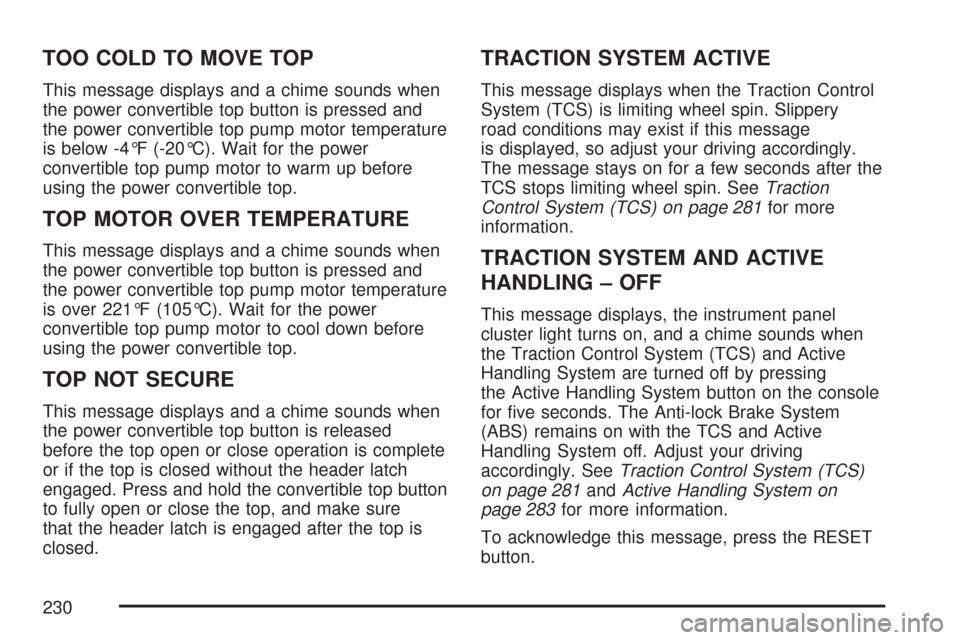
TOO COLD TO MOVE TOP
This message displays and a chime sounds when
the power convertible top button is pressed and
the power convertible top pump motor temperature
is below -4°F (-20°C). Wait for the power
convertible top pump motor to warm up before
using the power convertible top.
TOP MOTOR OVER TEMPERATURE
This message displays and a chime sounds when
the power convertible top button is pressed and
the power convertible top pump motor temperature
is over 221°F (105°C). Wait for the power
convertible top pump motor to cool down before
using the power convertible top.
TOP NOT SECURE
This message displays and a chime sounds when
the power convertible top button is released
before the top open or close operation is complete
or if the top is closed without the header latch
engaged. Press and hold the convertible top button
to fully open or close the top, and make sure
that the header latch is engaged after the top is
closed.
TRACTION SYSTEM ACTIVE
This message displays when the Traction Control
System (TCS) is limiting wheel spin. Slippery
road conditions may exist if this message
is displayed, so adjust your driving accordingly.
The message stays on for a few seconds after the
TCS stops limiting wheel spin. SeeTraction
Control System (TCS) on page 281for more
information.
TRACTION SYSTEM AND ACTIVE
HANDLING – OFF
This message displays, the instrument panel
cluster light turns on, and a chime sounds when
the Traction Control System (TCS) and Active
Handling System are turned off by pressing
the Active Handling System button on the console
for �ve seconds. The Anti-lock Brake System
(ABS) remains on with the TCS and Active
Handling System off. Adjust your driving
accordingly. SeeTraction Control System (TCS)
on page 281andActive Handling System on
page 283for more information.
To acknowledge this message, press the RESET
button.
230
Page 235 of 488
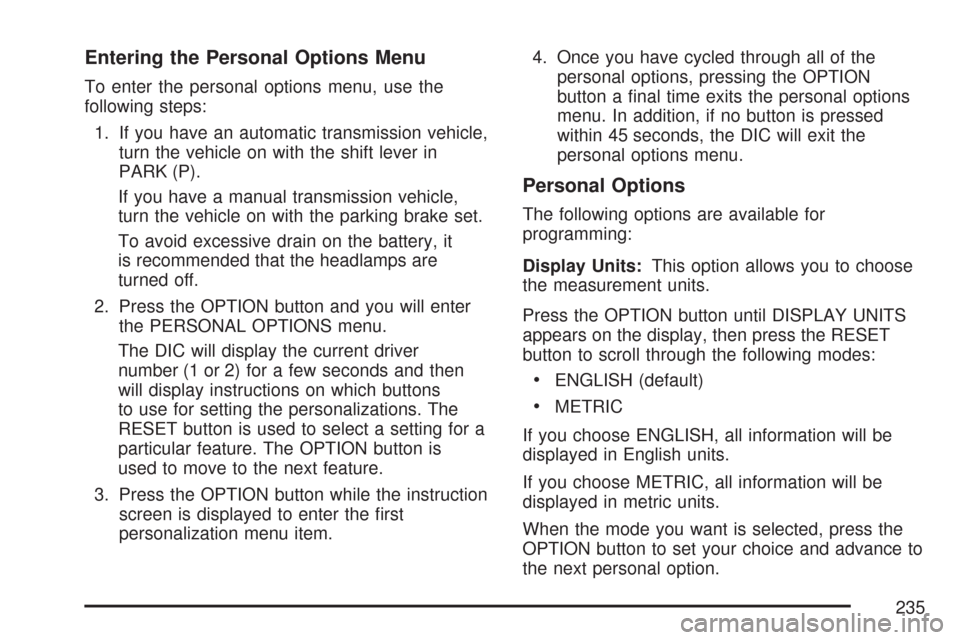
Entering the Personal Options Menu
To enter the personal options menu, use the
following steps:
1. If you have an automatic transmission vehicle,
turn the vehicle on with the shift lever in
PARK (P).
If you have a manual transmission vehicle,
turn the vehicle on with the parking brake set.
To avoid excessive drain on the battery, it
is recommended that the headlamps are
turned off.
2. Press the OPTION button and you will enter
the PERSONAL OPTIONS menu.
The DIC will display the current driver
number (1 or 2) for a few seconds and then
will display instructions on which buttons
to use for setting the personalizations. The
RESET button is used to select a setting for a
particular feature. The OPTION button is
used to move to the next feature.
3. Press the OPTION button while the instruction
screen is displayed to enter the �rst
personalization menu item.4. Once you have cycled through all of the
personal options, pressing the OPTION
button a �nal time exits the personal options
menu. In addition, if no button is pressed
within 45 seconds, the DIC will exit the
personal options menu.
Personal Options
The following options are available for
programming:
Display Units:This option allows you to choose
the measurement units.
Press the OPTION button until DISPLAY UNITS
appears on the display, then press the RESET
button to scroll through the following modes:
ENGLISH (default)
METRIC
If you choose ENGLISH, all information will be
displayed in English units.
If you choose METRIC, all information will be
displayed in metric units.
When the mode you want is selected, press the
OPTION button to set your choice and advance to
the next personal option.
235
Page 236 of 488
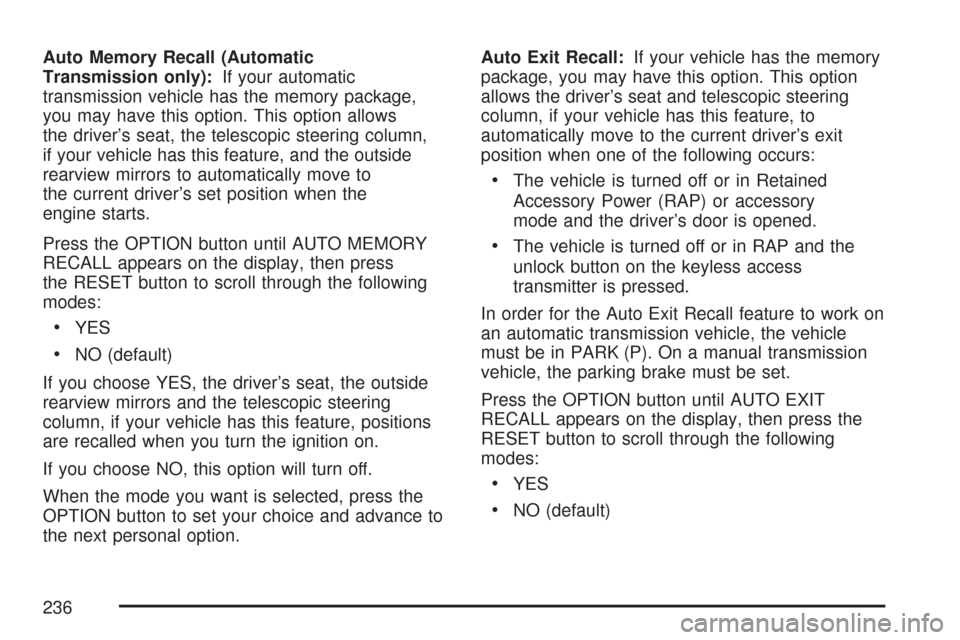
Auto Memory Recall (Automatic
Transmission only):If your automatic
transmission vehicle has the memory package,
you may have this option. This option allows
the driver’s seat, the telescopic steering column,
if your vehicle has this feature, and the outside
rearview mirrors to automatically move to
the current driver’s set position when the
engine starts.
Press the OPTION button until AUTO MEMORY
RECALL appears on the display, then press
the RESET button to scroll through the following
modes:
YES
NO (default)
If you choose YES, the driver’s seat, the outside
rearview mirrors and the telescopic steering
column, if your vehicle has this feature, positions
are recalled when you turn the ignition on.
If you choose NO, this option will turn off.
When the mode you want is selected, press the
OPTION button to set your choice and advance to
the next personal option.Auto Exit Recall:If your vehicle has the memory
package, you may have this option. This option
allows the driver’s seat and telescopic steering
column, if your vehicle has this feature, to
automatically move to the current driver’s exit
position when one of the following occurs:
The vehicle is turned off or in Retained
Accessory Power (RAP) or accessory
mode and the driver’s door is opened.
The vehicle is turned off or in RAP and the
unlock button on the keyless access
transmitter is pressed.
In order for the Auto Exit Recall feature to work on
an automatic transmission vehicle, the vehicle
must be in PARK (P). On a manual transmission
vehicle, the parking brake must be set.
Press the OPTION button until AUTO EXIT
RECALL appears on the display, then press the
RESET button to scroll through the following
modes:
YES
NO (default)
236
Page 273 of 488

Your Driving, the Road, and Your Vehicle.... 274
Defensive Driving...................................... 274
Drunken Driving........................................ 275
Control of a Vehicle.................................. 278
Braking...................................................... 278
Anti-Lock Brake System (ABS).................. 279
Braking in Emergencies............................. 281
Traction Control System (TCS).................. 281
Active Handling System............................. 283
Limited-Slip Rear Axle............................... 285
Selective Ride Control............................... 286
Steering.................................................... 286
Off-Road Recovery.................................... 289
Passing..................................................... 289
Loss of Control.......................................... 291
Racing or Other Competitive Driving.......... 292Driving at Night......................................... 293
Driving in Rain and on Wet Roads............ 295
City Driving............................................... 297
Freeway Driving........................................ 298
Before Leaving on a Long Trip.................. 300
Highway Hypnosis..................................... 301
Hill and Mountain Roads........................... 302
Winter Driving........................................... 304
If Your Vehicle is Stuck in Sand,
Mud, Ice, or Snow................................. 308
Rocking Your Vehicle to Get It Out........... 309
Loading Your Vehicle................................ 309
Towing........................................................ 315
Towing Your Vehicle................................. 315
Recreational Vehicle Towing...................... 315
Towing a Trailer........................................ 315
Section 4 Driving Your Vehicle
273
Page 278 of 488
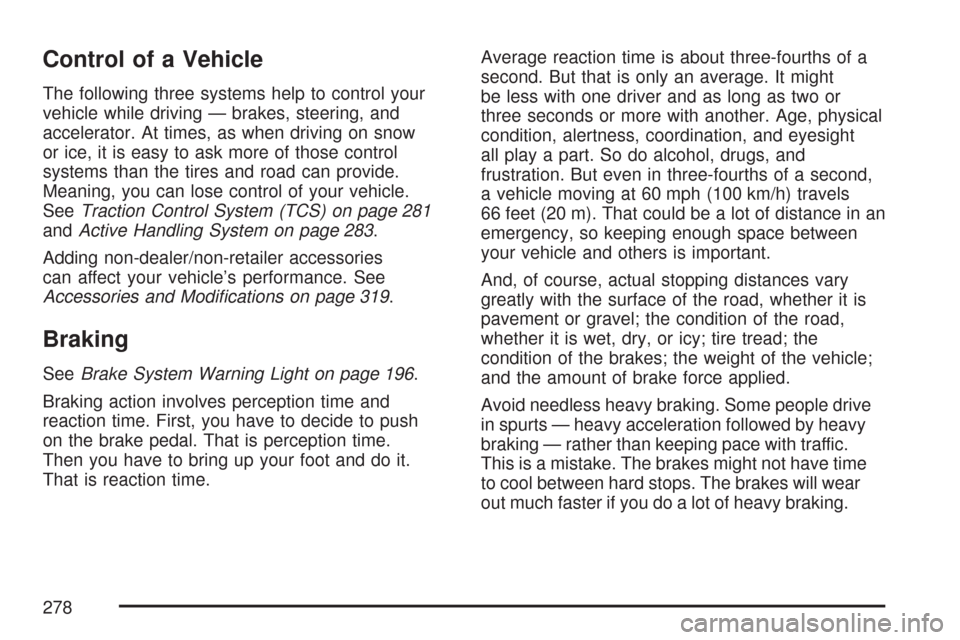
Control of a Vehicle
The following three systems help to control your
vehicle while driving — brakes, steering, and
accelerator. At times, as when driving on snow
or ice, it is easy to ask more of those control
systems than the tires and road can provide.
Meaning, you can lose control of your vehicle.
SeeTraction Control System (TCS) on page 281
andActive Handling System on page 283.
Adding non-dealer/non-retailer accessories
can affect your vehicle’s performance. See
Accessories and Modi�cations on page 319.
Braking
SeeBrake System Warning Light on page 196.
Braking action involves perception time and
reaction time. First, you have to decide to push
on the brake pedal. That is perception time.
Then you have to bring up your foot and do it.
That is reaction time.Average reaction time is about three-fourths of a
second. But that is only an average. It might
be less with one driver and as long as two or
three seconds or more with another. Age, physical
condition, alertness, coordination, and eyesight
all play a part. So do alcohol, drugs, and
frustration. But even in three-fourths of a second,
a vehicle moving at 60 mph (100 km/h) travels
66 feet (20 m). That could be a lot of distance in an
emergency, so keeping enough space between
your vehicle and others is important.
And, of course, actual stopping distances vary
greatly with the surface of the road, whether it is
pavement or gravel; the condition of the road,
whether it is wet, dry, or icy; tire tread; the
condition of the brakes; the weight of the vehicle;
and the amount of brake force applied.
Avoid needless heavy braking. Some people drive
in spurts — heavy acceleration followed by heavy
braking — rather than keeping pace with traffic.
This is a mistake. The brakes might not have time
to cool between hard stops. The brakes will wear
out much faster if you do a lot of heavy braking.
278
Page 279 of 488
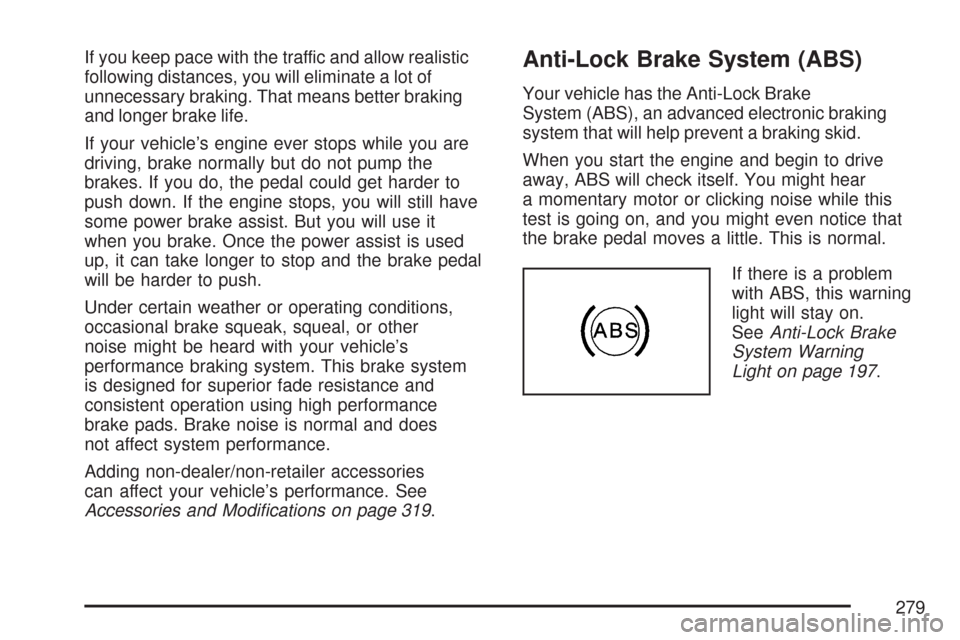
If you keep pace with the traffic and allow realistic
following distances, you will eliminate a lot of
unnecessary braking. That means better braking
and longer brake life.
If your vehicle’s engine ever stops while you are
driving, brake normally but do not pump the
brakes. If you do, the pedal could get harder to
push down. If the engine stops, you will still have
some power brake assist. But you will use it
when you brake. Once the power assist is used
up, it can take longer to stop and the brake pedal
will be harder to push.
Under certain weather or operating conditions,
occasional brake squeak, squeal, or other
noise might be heard with your vehicle’s
performance braking system. This brake system
is designed for superior fade resistance and
consistent operation using high performance
brake pads. Brake noise is normal and does
not affect system performance.
Adding non-dealer/non-retailer accessories
can affect your vehicle’s performance. See
Accessories and Modi�cations on page 319.Anti-Lock Brake System (ABS)
Your vehicle has the Anti-Lock Brake
System (ABS), an advanced electronic braking
system that will help prevent a braking skid.
When you start the engine and begin to drive
away, ABS will check itself. You might hear
a momentary motor or clicking noise while this
test is going on, and you might even notice that
the brake pedal moves a little. This is normal.
If there is a problem
with ABS, this warning
light will stay on.
SeeAnti-Lock Brake
System Warning
Light on page 197.
279